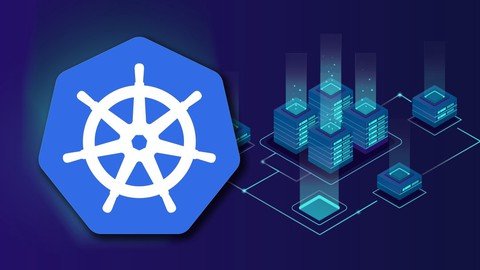
Published 9/2022
MP4 | Video: h264, 1280x720 | Audio: AAC, 44.1 KHz
Language: English | Size: 1.06 GB | Duration: 2h 24m
Learn Kubernetes in simple, easy and fun way with hands-on coding exercises. For beginners in DevOps.
What you'll learn
Develop Kubernetes Configuration Files in YAML
Deploy Applications on Kubernetes
Deploy Kubernetes Cluster on local systems
Gain basic understanding of Kubernetes Fundamentals
Deploy Kubernetes on Cloud - Google Cloud Platform
Setup ReplicaSets, Services and Deployments on Kubernetes
Requirements
Basic Linux Commands
Basic System Administration
Have access to a laptop or system to setup Kubernetes
Description
Kubernetes is an open-source system for automating deployment, scaling, and management of containerized applications. It was originally designed by Google and is now maintained by the Cloud Native Computing Foundation.Kubernetes is at the cutting-edge of application deployment. The best way to kick-start your DevOps career is by learning how to effectively deploy Kubernetes.This course is for absolute Kubernetes beginners. With zero knowledge about Kubernetes, once you take this course and complete all of the hands-on coding exercises, you will be ready to deploy your own applications on a Kubernetes platform.You will start your journey as a beginner and go through 10 simple, step-by-step lectures. Each lecture and demo is designed to give you the time to fully grasp all of the concepts. The most important part of the course is the series of hands-on coding exercises that accompany each major concept.You will be developing your own services using Kubernetes configuration files for different use cases right in your browser. The coding exercises will validate your commands to make sure you have written them correctly.After you have completed the lectures and coding exercises you will have the opportunity to complete a series of assignments that put your new skills to the test. You will be given a challenge to solve using the Kubernetes skills you have learned.
Overview
Section 1: Introduction
Lecture 1 1.1 What is Kubernetes
Lecture 2 1.2 Importance of Kubernetes
Lecture 3 1.3 Benefits of Kubernetes
Lecture 4 1.4 Kubernetes Components
Lecture 5 1.5 Kubernetes vs Docker Swarm
Section 2: 2
Lecture 6 2.1 What is Minikube
Lecture 7 2.2 Installing minikube on ubuntu
Lecture 8 2.3 What is Kubectl
Lecture 9 2.4 Installing Kubctl on ubuntu
Lecture 10 2.5. kubectl commands
Section 3: 3
Lecture 11 3.1 Containers and pods
Lecture 12 3.2 Manifest for a pod
Lecture 13 3.3 Static pods
Lecture 14 3.4 Creating a static pod
Lecture 15 3.5 Multi container pods
Lecture 16 3.6 Sidecar containers
Lecture 17 3.7 Creating a sidecar container
Lecture 18 3.8 init containers
Lecture 19 3.9 Creating init containers
Section 4: 4
Lecture 20 4.1. What is a Deployment
Lecture 21 4.2. Working with Deployments
Section 5: 5
Lecture 22 5.1. What is a Replication Controller
Lecture 23 5.2. Working with Replication Controller
Lecture 24 5.3. Need for ReplicaSet
Lecture 25 5.4. Working with ReplicaSet
Section 6: 6
Lecture 26 6.1. Horizontal Pod Autoscaling
Lecture 27 6.2. HPA in action
Section 7: 7
Lecture 28 7.1. Jobs
Lecture 29 7.2. Creating Jobs
Lecture 30 7.3 Cron Jobs
Lecture 31 7.4. Creating Cron Jobs
Section 8: 8
Lecture 32 8.1 What is Daemonset
Lecture 33 8.2. Creating a Daemonset
Lecture 34 8.3. What is Statefulset
Lecture 35 8.4 Creating a Statefulset.
Section 9: 9
Lecture 36 9.1 What are configmaps
Lecture 37 9.2. Creating configmaps for storing raw data
Lecture 38 9.3 What are secrets
Lecture 39 9.4. Creating secrets for storing sensitive data
Section 10: 10
Lecture 40 10.1. What are Persistent Volumes
Lecture 41 10.2. What is a Persistent Volume Claim
Lecture 42 10.3 What are storage classes
Lecture 43 10.4. Working with Persistent volumes
Lecture 44 10.5. Working with storage classes.mp4
Section 11: 11
Lecture 45 11.1. ClusterIP
Lecture 46 11.2. Creating a cluster IP service
Lecture 47 11.3. Nodeport
Lecture 48 11.4. Creating a Nodeport IP service
Lecture 49 11.5. Load Balancer
Lecture 50 11.6. Creating Loadbalancer service
Section 12: 12
Lecture 51 12.1. Ingress and Ingress Class
Lecture 52 12.2. Endpoint
Lecture 53 12.3 Endpoint Slice
Lecture 54 12.4. Creating an Ingress
Section 13: 13
Lecture 55 13.1. Role and Role Bindings
Lecture 56 13.2
Lecture 57 13.3 Clusterrole and Cluster Role Binding
Lecture 58 13.4. Working with Cluster Roles
Section 14: 14
Lecture 59 14.1. Taints and Tolerations
Lecture 60 14.2. Resource Limits and Requests
Section 15: 15
Lecture 61 15.1 Conclusion and Thanks
Beginners in Containers,Beginners in Orchestration,System Administrators,Developers,Project Managers
Homepage
https://www.udemy.com/course/kubernetes-for-the-absolute-beginners-hands-on/
https://rapidgator.net/file/2272a1f6da17ca7fc132737dd8f72948/wkrsm.Kubernetes.For.The.Absolute.Beginners..HandsOn..Udemy.part2.rar.html
https://rapidgator.net/file/637bda68d759c4f61ca53d1c28fb4701/wkrsm.Kubernetes.For.The.Absolute.Beginners..HandsOn..Udemy.part1.rar.html

https://uploadgig.com/file/download/14c0d4bfd3D4ab3a/wkrsm.Kubernetes.For.The.Absolute.Beginners..HandsOn..Udemy.part1.rar
https://uploadgig.com/file/download/aBa16ad368721faa/wkrsm.Kubernetes.For.The.Absolute.Beginners..HandsOn..Udemy.part2.rar

https://nitroflare.com/view/3A8747844E39778/wkrsm.Kubernetes.For.The.Absolute.Beginners..HandsOn..Udemy.part2.rar
https://nitroflare.com/view/64ECD3A60BA36B1/wkrsm.Kubernetes.For.The.Absolute.Beginners..HandsOn..Udemy.part1.rar
